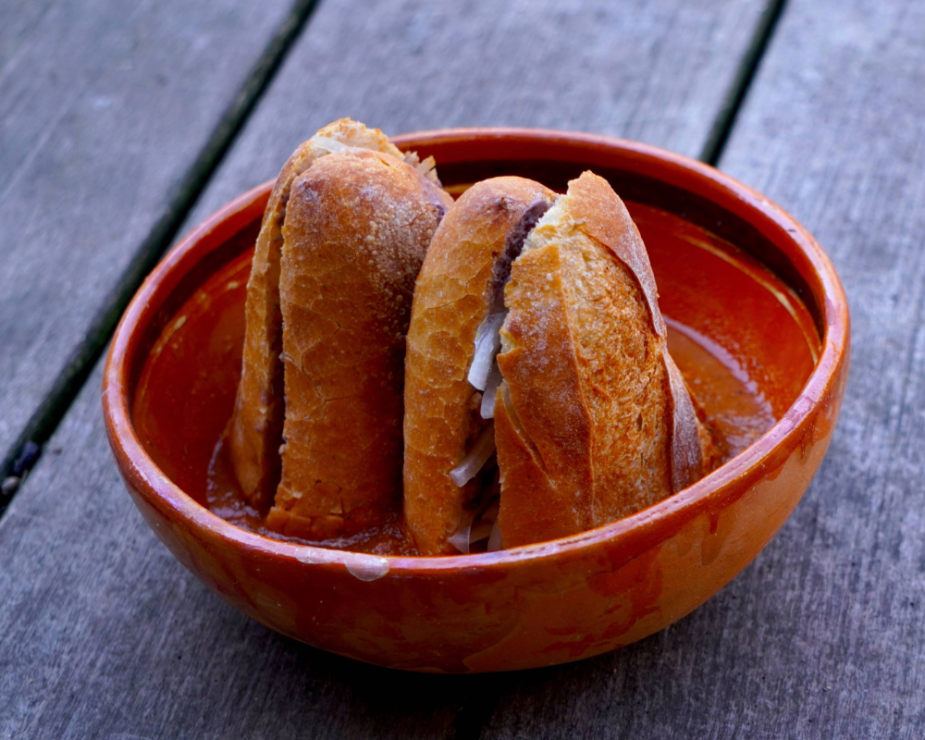
The first thing people will tell you about this delectably messy, potentially fiery Guadalajara icon is that you can’t make it without a proper birote, the seriously crusty, deeply flavored roll of the region. Many places that make tortas ahogadas across the country actually express ship birotes to ensure authenticity. Personally, I consider a crusty sour-dough demi-baguette a good stand-in–or even an artisan bolillo. The bread just has to have enough integrity to stand up to “drowning” in the sauce without falling apart.
Once the bread is settled, the torta construction is straight-forward: a smear of black beans followed by a heap of carnitas (and, in the best version I’ve ever had, a scattering of oregano-scented pickley white onions), then drenched in mild tomato sauce and, finally, splashed with incendiary árbol chile sauce. The amount of arbol you add is to your own discretion, though when most folks in Mexico hear the words “torta ahogada,” they suck in a hissing gasp of air through their teeth and shake their heads, acknowledging the torta’s legendary spiciness.
Feel free to bring home carnitas from a neighborhood carnitas spot or Mexican grocery (most meat markets in those stores usually make carnitas) or make the simple version.
Note: If your local fresh tomatoes are in season, replace the canned with about 12 ounces of ripe tomatoes (preferably romas). If using fresh tomatoes, spread them on a rimmed baking sheet and roast about 4 inches below a very hot broiler until blackened and blistered, about 6 minutes. Flip and roast the other side. Cool, then peel off the blackened skins and discard. Scoop about ⅔ of the tomatoes and all their juices into a blender jar. Set the other ⅓ aside in a bowl.
INGREDIENTS
- 1 medium white onion, thinly sliced (divided use)
- 2/3 cup vinegar (any light vinegar will do) (divided use)
- 1/2 teaspoon dried Mexican oregano,
- Salt
- 1 15 ounce can tomatoes (preferably fire-roasted) (divided use)
- 2 tablespoons vegetable or olive oil
- 8 garlic cloves, peeled, whole (divided use)
- 3 1/2 cups chicken broth
- 10 árbol chiles , stemmed
- About 2/3 cup cooked beans (any color is welcome here) with just enough liquid to cover, canned or home-cooked
- 1 or 2 tablespoons fresh-rendered pork lard or vegetable oil
- 4 birote rolls or 8-inch demi-baguettes
- About 1 pound carnitas (homemade or bought from a grocery or taqueria that makes carnitas), warm
INSTRUCTIONS
Make the quick pickled onions. Scoop half of the onion into a heatproof bowl. Pour ½ cup of the vinegar into a small saucepan, add an equal amount of water, the oregano and ½ teaspoon of salt. Bring to a boil and pour over the onions. Set aside until you’re ready to serve. (The pickled onions can be made ahead; covered, they keep well in the refrigerator for several weeks.)
Make the tomato sauce. For canned tomatoes, tip off most of the juice into a blender jar, then scrape ⅔ of the tomatoes into the blender jar, leaving the other ⅓ in the can. In a large (10-inch) skillet over medium heat, heat the oil. Add the garlic and cook until the cloves are beginning to color and soften, about 3 minutes. Scoop half the garlic into a small dish, then add the remaining onion to the pan, return to the heat and cook, stirring regularly, until the onion is softened and golden, about 8 minutes more. Scrape the onion mixture in with the tomatoes and blend until smooth. Scrape into a medium (2-quart) saucepan, stir in the broth and set over medium-high heat. When the sauce comes to a simmer, reduce the heat to medium-low, partially cover and let gently simmer for 30 minutes or so. The tomato sauce should be brothy — not the least bit thick. Taste and season with salt, usually about 1/2 teaspoon, depending on the saltiness of your broth.
Make the arbol salsa. Meanwhile, return the garlic-onion skillet (no need to wash) to medium heat. When hot, scatter in the arbol chiles and stir for about 30 seconds or so until they have browned in spots and are aromatic. Scrape them into the blender (no need to wash), add the reserved tomatoes and garlic, remaining vinegar (about 3 tablespoons), ⅓ cup water and blend until smooth. Taste (it’s spicy!) and season with salt, usually about 1 teaspoon.
Make the bean puree. Scrape the beans into a blender or food processor, add the lard or oil and process until smooth. Taste and season with salt, if necessary.
Construct and serve the tortas. When it’s time to serve, I like to splash or spray the bread with water and “refresh” in a 350-degree oven for a few minutes to re-crisp. Cut the bread in half around their equators, then scoop out some of the soft interiors. Spread a generous 2 tablespoons of the bean spread over each bottom, then top with a portion of the warm carnitas and the pickled onion.
Here’s where you have to make a choice: These are typically “drowned” in sauce and salsa and eaten with gusto and fingertips. (To minimize mess, some restaurants offer cheap plastic gloves or plastic bags to put your hand into.) I’ve seen some cooks put the sauce and salsa over the meat, but then the torta isn’t really living up to its name. At Xoco, our torta-centric restaurant, we partially fill a deep soup bowl with sauce and salsa, cut the torta in half, then stand the two halves, cut-side down, half in, half out of the saucy stuff.
Whichever way you choose, the torta gets the sauce and as much of the very spicy salsa as each of your friends and family is up for. If there is árbol salsa left over, it will keep in the refrigerator for a week or so.




